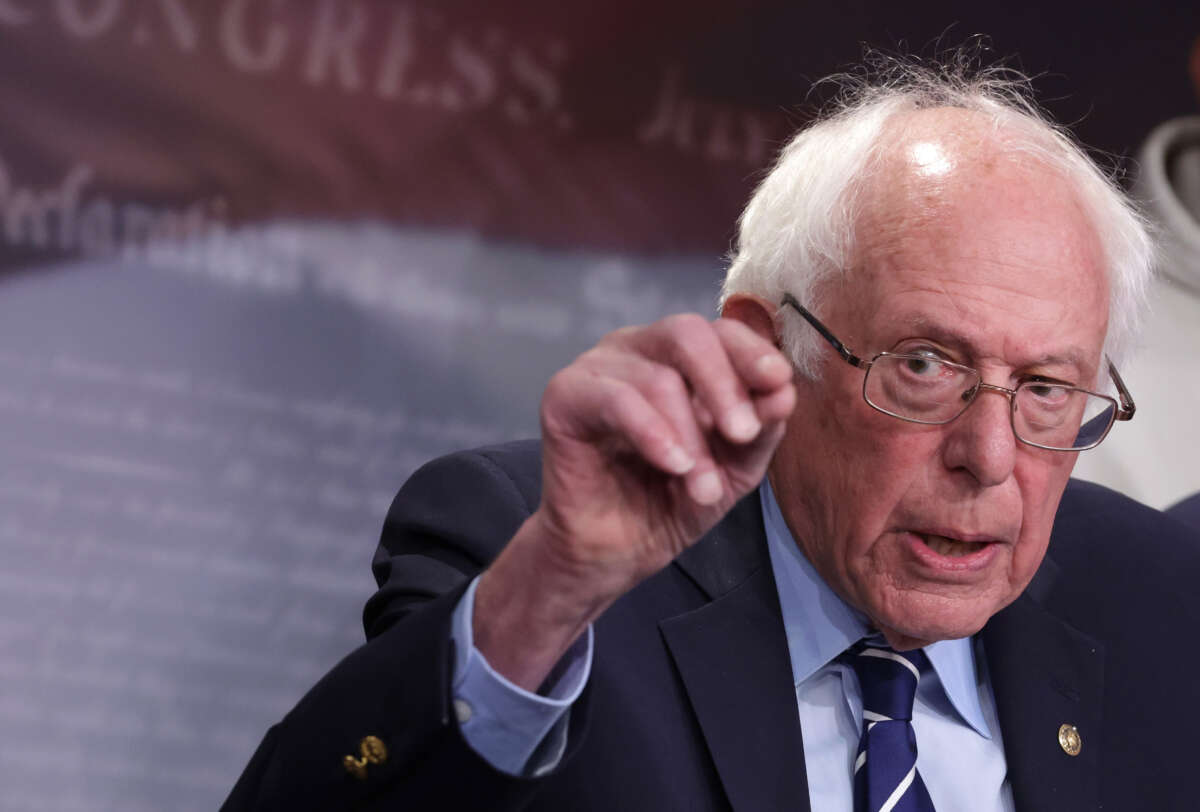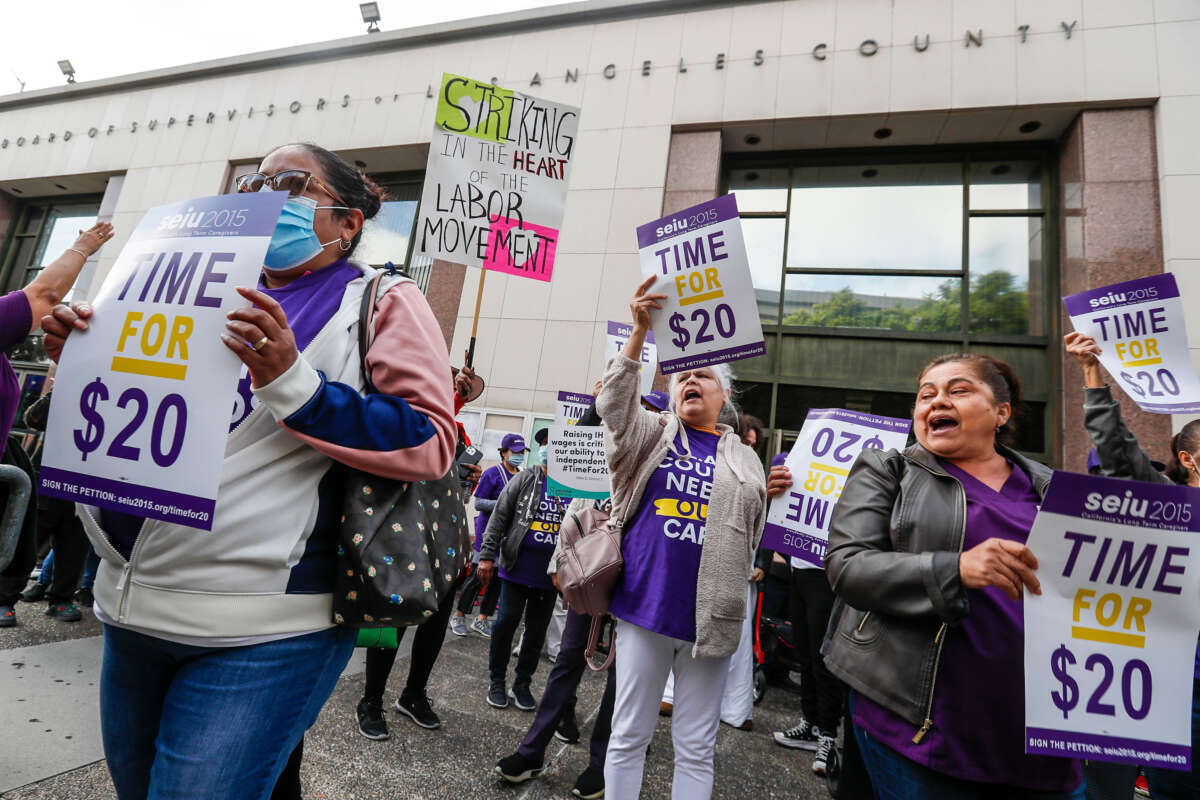Sanders Report Uncovers Looming Child Care Cliff If Congress Lets Funding Expire
One in 5 child care centers will soon have to decrease the number of children they serve if Congress fails to act.
By Sharon Zhang ,

Poll Finds 4 in 5 Voters Support Capping Child Care Costs for All Families in US
Polling finds that 90 percent of voters who are parents are concerned about child care costs.
By Sharon Zhang , TRUTHOUTMay 12, 2023
In an industry that has already lost 100,000 workers through the course of the pandemic, in large part due to low pay, forcing wages to stay stagnant or become even lower would be disastrous for the labor force. Bureau of Labor Statistics data shows that child care workers make a median wage of just $13.22 an hour, or $27,490 a year — not even enough for a worker to afford their own service, with child care costing about $16,000 a year on average across the country as of 2021.
On the other hand, the report cites findings from HHS that the stimulus funding has helped families of at least 700,000 children access lower health care costs. Ohio used the funding to implement provisions like free child care for eligible families, while Montana capped copayments to $10 a month for certain families. In West Virginia, administrators were able to expand child care subsidies for “essential” workers during the pandemic. And, in North Carolina and Michigan, the funding paved the way for an increase in child care subsidies for lower-income families.
Congress must authorize permanent investments in child care to begin to heal a system “that is hanging on by a thread,” the report read.
Sanders pointed out that the cost of child care is “outrageously high” in a HELP hearing on the subject on Wednesday, citing surveys that have found that roughly 40 percent of parents report being unable to afford child care and going into debt in order to obtain it.
“In other words, you want to have a child in America and you’re working class? Well, we’re going to make you pay for that. You’re going to go deeply in debt. Thank you for having a child. Not exactly what I think we should be doing as a nation,” the senator said.
“If Congress does nothing, this funding will expire on September 30th of this year, making a very bad situation worse. We cannot allow that to happen. We need to renew that vital funding,” he said.
But, Sanders added, “That is not all we need to do. We need a vision — for all those with the family values — we need a vision for the future which understands that every family in America has the right to high quality, affordable child care, that child care workers deserve decent pay for the important work they do, and we must expand the number of child care programs available so anybody in America can get the quality child care they need.”
One in 5 child care centers will soon have to decrease the number of children they serve if Congress fails to act.
By Sharon Zhang ,
PublishedMay 31, 2023

Sen. Bernie Sanders speaks during a news conference at the U.S. Capitol on May 18, 2023, in Washington, D.C.
ALEX WONG / GETTY IMAGES
Sen. Bernie Sanders (I-Vermont) released a report on Tuesday finding that the U.S. is quickly hurtling toward a child care cliff that will plunge the country even deeper into its child care crisis come September unless Congress acts.
The report, released by Health, Education, Labor and Pensions (HELP) Committee chair Sanders and member Sen. Patty Murray (D-Washington), finds that both families and child care workers will face trouble if the child care funding passed in the COVID-19 economic stimulus bills is allowed to expire this fall.
According to data from the Department of Health and Human Services (HHS), those grants have helped more than 220,000 child care providers and served nearly 10 million children across the country. This funding was a saving grace for the child care industry at a time when the industry was already in deep crisis — with sky-high prices and a vast labor shortage, which are still at play despite the increased funding of about $37.5 billion provided by various stimulus packages.
These problems will worsen when the extra aid runs out on September 30, the report finds. According to a National Association for the Education of Young Children survey of over 12,000 early child care educators conducted last November and cited by the report, 19 percent of family child care providers say they will have to cut the amount of children they can serve when the funding expires. Forty-three percent of child care center directors said they would have to raise tuition.
Meanwhile, these centers would be forced to lose or cut wages for staff, the survey found. Over one-fourth of child care providers said they would have to cut wages or salary increases, and over one-fifth of center directors said they’d have to lay off staff altogether.
RELATED STORY
Sen. Bernie Sanders (I-Vermont) released a report on Tuesday finding that the U.S. is quickly hurtling toward a child care cliff that will plunge the country even deeper into its child care crisis come September unless Congress acts.
The report, released by Health, Education, Labor and Pensions (HELP) Committee chair Sanders and member Sen. Patty Murray (D-Washington), finds that both families and child care workers will face trouble if the child care funding passed in the COVID-19 economic stimulus bills is allowed to expire this fall.
According to data from the Department of Health and Human Services (HHS), those grants have helped more than 220,000 child care providers and served nearly 10 million children across the country. This funding was a saving grace for the child care industry at a time when the industry was already in deep crisis — with sky-high prices and a vast labor shortage, which are still at play despite the increased funding of about $37.5 billion provided by various stimulus packages.
These problems will worsen when the extra aid runs out on September 30, the report finds. According to a National Association for the Education of Young Children survey of over 12,000 early child care educators conducted last November and cited by the report, 19 percent of family child care providers say they will have to cut the amount of children they can serve when the funding expires. Forty-three percent of child care center directors said they would have to raise tuition.
Meanwhile, these centers would be forced to lose or cut wages for staff, the survey found. Over one-fourth of child care providers said they would have to cut wages or salary increases, and over one-fifth of center directors said they’d have to lay off staff altogether.
RELATED STORY

Poll Finds 4 in 5 Voters Support Capping Child Care Costs for All Families in US
Polling finds that 90 percent of voters who are parents are concerned about child care costs.
By Sharon Zhang , TRUTHOUTMay 12, 2023
In an industry that has already lost 100,000 workers through the course of the pandemic, in large part due to low pay, forcing wages to stay stagnant or become even lower would be disastrous for the labor force. Bureau of Labor Statistics data shows that child care workers make a median wage of just $13.22 an hour, or $27,490 a year — not even enough for a worker to afford their own service, with child care costing about $16,000 a year on average across the country as of 2021.
On the other hand, the report cites findings from HHS that the stimulus funding has helped families of at least 700,000 children access lower health care costs. Ohio used the funding to implement provisions like free child care for eligible families, while Montana capped copayments to $10 a month for certain families. In West Virginia, administrators were able to expand child care subsidies for “essential” workers during the pandemic. And, in North Carolina and Michigan, the funding paved the way for an increase in child care subsidies for lower-income families.
Congress must authorize permanent investments in child care to begin to heal a system “that is hanging on by a thread,” the report read.
Sanders pointed out that the cost of child care is “outrageously high” in a HELP hearing on the subject on Wednesday, citing surveys that have found that roughly 40 percent of parents report being unable to afford child care and going into debt in order to obtain it.
“In other words, you want to have a child in America and you’re working class? Well, we’re going to make you pay for that. You’re going to go deeply in debt. Thank you for having a child. Not exactly what I think we should be doing as a nation,” the senator said.
“If Congress does nothing, this funding will expire on September 30th of this year, making a very bad situation worse. We cannot allow that to happen. We need to renew that vital funding,” he said.
But, Sanders added, “That is not all we need to do. We need a vision — for all those with the family values — we need a vision for the future which understands that every family in America has the right to high quality, affordable child care, that child care workers deserve decent pay for the important work they do, and we must expand the number of child care programs available so anybody in America can get the quality child care they need.”




















